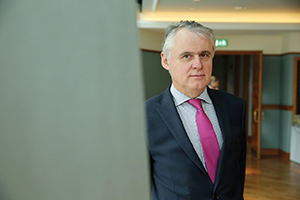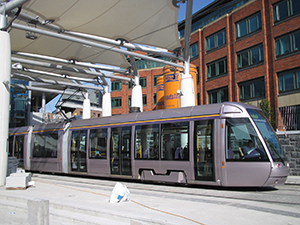Future outlook for Irish PPP market
Brian Murphy, Director of the National Development Finance Agency (NDFA), talks to Owen McQuade about the state of the PPP market in Ireland and the outlook for attracting institutional investors.

The National Development Finance Agency has a dual role in the infrastructure market: a role as a financial adviser and also a procurement role in PPPs for social infrastructure including primary care centres, court services, schools and social housing. NDFA’s advisory role has a broader remit which also includes transport infrastructure. In its transport role it has acted as financial adviser to Transport Infrastructure Ireland (TII) on the LUAS Cross City project and several motorway projects.
The current raft of PPP projects came about when the last Coalition Government announced a stimulus package in 2012 which included €1.8 billion of PPP projects. This consisted of €750 million of social infrastructure including schools, primary care centres and courthouses. The balance was transport projects, mostly motorways (M11, M7, M25 and M17/M18). Most of these projects have been procured and a number are in construction, with the remaining projects approaching financial close. Schools PPP Bundle 4 closed at the end of 2014, the Courthouses project closed just before Christmas 2015 and both these projects are now in construction, with the first school in Bundle 4 about to be handed over.
The Primary Care Centres project is a ‘pathfinder’ project for primary care PPPs. NDFA is approaching financial close on the project which consists of 14 primary care centres spread across the country. “That is what is nice about social infrastructure. It has a good geographic spread, which fits in with the rationale for the stimulus package which was to address rising unemployment and depressed economic activity, particularly outside Dublin,” observes Brian Murphy.
The projects in the stimulus package include social and community gain clauses which are aimed at giving job opportunities to the long-term unemployed and also providing opportunities for apprentices. NDFA also ran a series of ‘meet the buyer’ events in conjunction with Enterprise Ireland to facilitate SMEs getting involved in the supply chain for the tenders. “We ran seven of these events around the country and some SMEs have had good success out of that. Some of the preferred tenderers now have new suppliers that they previously didn’t know existed,” says Murphy.
Construction will start on the Schools PPP Bundle 5 in June of this year and the project comprises six facilities: five schools and one institute of further education. The remaining project in the stimulus package is the Grangegorman PPP project, to be built on the grounds of St. Brendan’s Hospital in Grangegorman in Dublin 7, which are being developed as a new campus for Dublin Institute of Technology. The project is now subject to litigation after the preferred tenderer stage was reached in April 2015.
Future capital expenditure
In relation to future activity, the Government announced a new capital programme in September 2015. Although most of the programme is to be financed on-balance sheet there are some additional PPPs, including part of the social housing programme which is to be delivered by availability PPPs totalling €300 million in three bundles of €100 million. NDFA will be the procuring body for these three bundles and will act as an agent for DECLG and the various local authorities. For the first bundle the sites have been identified. The rest of the PPP opportunity in the capital programme is €650 million with approximately €500 million in the health, justice and education sectors and another €150 million in student housing.
 The total capital programme is €42.5 billion of which €14.5 billion is capital expenditure by the commercial semi-state companies and €27 billion on-balance sheet public sector sending. “At the time the programme was launched, Minister Harris said that the plan would be subject to an early review in 2017 or earlier. If and when we get a new government I expect the programme is going to be revisited and priorities may change,” explains Murphy.
The total capital programme is €42.5 billion of which €14.5 billion is capital expenditure by the commercial semi-state companies and €27 billion on-balance sheet public sector sending. “At the time the programme was launched, Minister Harris said that the plan would be subject to an early review in 2017 or earlier. If and when we get a new government I expect the programme is going to be revisited and priorities may change,” explains Murphy.
PPP market
The market for PPP projects in Ireland has undergone a radical transformation in recent years. “When the stimulus package was launched in 2012, the market couldn’t believe that this was being launched as the country was in the process of being bailed out by the Troika. We were asked two questions by a somewhat incredulous market: Who is going to bid for and build these projects? And how are we going to finance them? At that time Ireland couldn’t borrow except from the European Investment Bank (EIB) and the Minister announced that €750 million in what was then the National Pensions Reserve Fund (NPRF) would be ring fenced to support the PPP pipeline,” says Murphy.
“The international project finance banks had completely pulled out of Ireland but we were confident of funding the programme as the NPRF was behind it and EIB had made positive noises,” he adds. NDFA then marketed the programme “relentlessly” and over time, those that had previously invested in the Irish PPP market began to listen and eventually re-enter the market.
“In relation to funding of projects, there has been an extraordinary transformation over a relatively short period of time. In respect of the deals we have closed over the past 18 months, we ran very active funding competitions in the market in conjunction with the Preferred Tenderers. In one case we had well over 30 expressions of interest from financiers. It has gone from one end of the spectrum to the other,” explains Murphy. The increased market interest has been reflected in the pricing and the value for money NDFA is getting now is “quite extraordinary” and a “once in a lifetime opportunity and I think it’s unlikely we will ever see pricing as attractive as this again.”
Murphy highlights the primary care project as being particularly innovative. The PPP model had not been used for primary care before and the HSE had been successful in delivering primary care centres but these were one-off projects, usually developer-led. With the PPP project the HSE will get a bundle of 14 centres in one go and the PPP consortium will manage those physical assets for the next 25 years. “At the end of that 25 year period the government gets back 14 primary care centres in pristine condition. We had a really good competition for this project. HSE was impressed with the innovation and the new ideas that come with the bids. The preferred bidder is Prime Balfour Beatty who, being large operators in the UK, have a lot of experience in this area and the project could become a template for future projects in the health care area,” says Murphy.
When asked if the new European Procurement Directives have impacted on NDFA, he replies: “Clearly the competitions we run are compliant with the European Directives, national procurement legislation and the ministerial guidelines – and they will all change over time. The new Directive will be transposed into Irish law very shortly.”
“The public procurement law is very prescriptive and we have to be extremely rigorous and there is a huge onus on us to be fair and transparent. We are very mindful of our responsibilities,” says Murphy.
On the overall state of the PPP market in Ireland Murphy is particularly upbeat. “The appetite for funding infrastructure in Ireland at the moment is quite extraordinary. We have gone from the position where the PPP market in Ireland was the black sheep, after a number of the PPP projects were cancelled in 2009-2010. Ireland is now the poster boy for PPPs in Europe. It is seen as a very active and attractive market. To sustain the market it would be helpful to see a good pipeline of projects for the next five years. That is important for investors to plan and commit resources to Ireland – they need to see a pipeline of projects over time. For several of our projects we have attracted new entrants – well-regarded international players who haven’t looked at Ireland before. We would like to keep these people interested in Ireland to ensure that we have a very active and therefore competitive market and that means value for money for the taxpayer,” he concludes.





